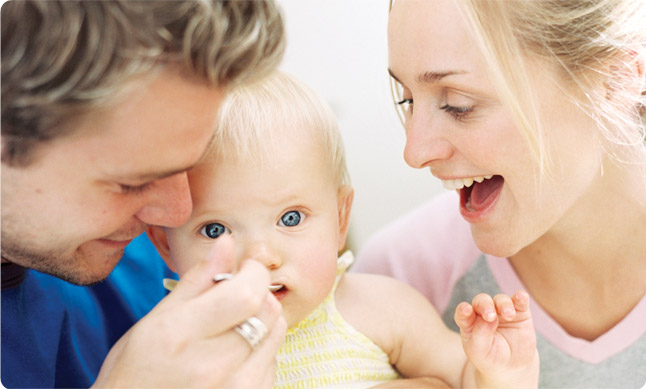Adding solid foods to mealtime is an exciting and important milestone for you and your baby, ranking up there with crawling and saying that long-awaited first word. Not only is your baby moving past the extrusion reflex and learning how to eat from a spoon, but she is finally getting to enjoy some of the same foods you love. Different than the bottle or breastfeeding, this is a new opportunity for bonding at the dinner table, and depending on your child’s aim, that bond may be literal on occasion with the flinging of food. Regardless of how much food makes it into baby’s mouth, each new flavor will offer a new experience. Each experience will contribute to food preferences that will last throughout your child’s lifetime. Before you move into the world of solid foods, it helps to be prepared. And you will need to add a few new feeding items to your child’s collection of bottles. Here are the basics:
• A high chair. Follow the safety guidelines set by the Juvenile Products Manufacturers Association
(www.jpma.org).
• Bibs, bibs and more bibs. Feeding time will be fun, but it will not be pretty. In addition to
experiencing new flavors, your child will also learn a new skill that requires coordination and spatial intelligence. Embrace the mess. Just make sure to cover baby with a bib that is comfortable and easy to clean.
• Bowls and plates. Choose serving dishes that are small (to aid in determining portions) and easy
to hold. Dishwasher safe items are a plus too!
• Feeding spoon. The best first spoon for baby will be one that is easy for mom to hold onto. Longer
handles are easier to maneuver, especially when your little one begins to help direct the spoon to face movement. Choose a spoon that is appropriately sized for baby’s small mouth and is not hard on sensitive gums.
• Training cup. Practicing drinking with a training cup will help improve feeding skills. When baby
begins drinking from a cup, choose a one with a soft spout that eases the transition a bottle nipple to
cup. As the comfort level with a cup rises and teething occurs, begin using cups with harder spouts
that are more durable when chewed.
Last but not least, make sure you come to the table armed with patience. This is truly a learning experience for baby, and it will take a while before she becomes a pro. Have fun, explore together, and don’t worry about whether or not she is getting enough solid food. During the first year of life, your child’s main source of nutrition will be from breast milk or formula. That’s nature’s way of working in a learning curve, leaving you time to enjoy this precious period in your little one’s development.
